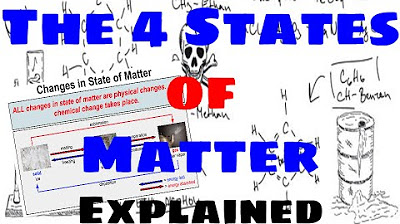NUCLEAR CHEMISTRY - Radioactivity & Radiation - Alpha, Beta, Gamma
Summary
TLDRIn this educational video, Mr. Post explores the concept of nuclear instability, explaining how an unfavorable ratio of protons to neutrons can destabilize an atom's nucleus. He introduces the nuclear strong force that normally holds the nucleus together but fails when the atom is unstable. The video delves into radioactivity, defining it as an unstable nucleus's spontaneous change and contrasting it with radiation, which is the actual emission of particles or energy. Mr. Post covers the three main types of nuclear radiation: alpha, beta, and gamma, each with its unique characteristics and effects on the nucleus's stability. The goal of radiation emission is to achieve a more stable nucleus.
Takeaways
- 🔬 Isotopes are different forms of the same element, varying in the number of neutrons.
- 🌐 The nuclear strong force is a mysterious force that holds the nucleus together despite the repulsion of protons.
- ⚠️ An unstable nucleus has an unfavorable ratio of protons to neutrons, leading to nuclear changes.
- 💥 The maximum number of protons naturally found in a nucleus is 92, as seen in uranium.
- 📉 Radioactivity is a sign of an unstable nucleus, which may undergo spontaneous changes.
- ➡️ Radiation is emitted from unstable nuclei and can be in the form of particles (alpha, beta) or energy (gamma).
- 🚀 Alpha particle decay involves the release of two protons and two neutrons, reducing the atomic number by two.
- 🔄 Beta particle decay occurs when a neutron converts into a proton and emits an electron.
- 🔆 Gamma radiation is high-energy radiation emitted from an unstable nucleus to increase stability without changing the element.
- 🔬 Nuclear chemistry focuses on changes within the nucleus, which contains protons and neutrons.
Q & A
What is an isotope?
-An isotope is a variant of a chemical element that has the same number of protons but a different number of neutrons in its nucleus, resulting in different atomic masses.
Why might a nucleus be unstable?
-A nucleus might be unstable due to an unfavorable combination of protons and neutrons, leading to too many protons pushing each other apart or too many neutrons causing instability.
What is the nuclear strong force?
-The nuclear strong force is the force that holds the nucleus of an atom together, operating over a small distance such as within the nucleus.
What is the maximum number of protons a naturally occurring nucleus can have?
-The maximum number of protons a naturally occurring nucleus can have is 92, as seen in uranium.
What is meant by the term 'radioactivity'?
-Radioactivity refers to the spontaneous process by which an unstable nucleus loses energy by emitting radiation, such as alpha, beta, or gamma radiation.
How does an atom become more stable through radiation?
-An atom becomes more stable by emitting radiation, which can be in the form of particles (alpha or beta) or energy (gamma), thus reducing the imbalance of protons and neutrons in the nucleus.
What is alpha particle decay?
-Alpha particle decay is a type of radioactive decay in which an unstable nucleus emits an alpha particle, which consists of two protons and two neutrons, effectively decreasing the atomic number by two and the mass number by four.
What is beta particle decay?
-Beta particle decay is a process where a neutron in an unstable nucleus is converted into a proton and an electron (beta particle), which is then emitted from the nucleus, increasing the atomic number by one.
How is gamma radiation different from alpha and beta radiation?
-Gamma radiation is not a particle but a high-energy electromagnetic wave emitted from an unstable nucleus. It does not change the atomic number or mass number of the nucleus, unlike alpha and beta radiation.
What is the role of the neutron in beta particle decay?
-In beta particle decay, a neutron in the nucleus is converted into a proton and an electron (beta particle). This process helps the nucleus achieve a more stable configuration by reducing the number of neutrons.
Why does the nuclear strong force fail in certain nuclei?
-The nuclear strong force fails in certain nuclei when the repulsive force between protons becomes too strong due to too many protons, or when the balance of protons to neutrons is unfavorable, leading to an unstable nucleus.
Outlines

このセクションは有料ユーザー限定です。 アクセスするには、アップグレードをお願いします。
今すぐアップグレードMindmap

このセクションは有料ユーザー限定です。 アクセスするには、アップグレードをお願いします。
今すぐアップグレードKeywords

このセクションは有料ユーザー限定です。 アクセスするには、アップグレードをお願いします。
今すぐアップグレードHighlights

このセクションは有料ユーザー限定です。 アクセスするには、アップグレードをお願いします。
今すぐアップグレードTranscripts

このセクションは有料ユーザー限定です。 アクセスするには、アップグレードをお願いします。
今すぐアップグレード関連動画をさらに表示

The Four States of Matter - Explained

Lab Equipment - Explained

3. Gr 11 Life Sciences - Population Ecology - Theory 3 Mark Recapture Method

4. Gr 11 Life Sciences - Population Ecology - Worksheet 1

PENJASKES KELAS X - SOFTBALL

Introduction to Culture [AP Human Geography Review Unit 3 Topic 1]

Menentukan Mr ( massa molekul relatif )
5.0 / 5 (0 votes)
